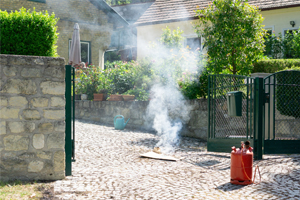C.G.S. § 53a-113 – Arson in the Third Degree
For a step-by-step overview of arrests, arraignments, and diversion options, see my Criminal Defense page.
Overview
Arson in the Third Degree targets fires or explosions that recklessly damage or endanger a building (as Connecticut defines it) when the fire/explosion was intentionally started. Unlike Arson 1st or 2nd, the focus here is on recklessness and endangerment/damage to a building, not on intent to injure or cause public alarm. It’s a Class C felony.
What the Prosecutor Must ProveTo convict under § 53a-113, the State must show that you intentionally started a fire or caused an explosion and recklessly:
- Caused the destruction or damage of a building of another, or
- Placed a building of another in danger of destruction or damage.
“Building” is defined broadly in Connecticut and can include certain vehicles/watercraft used for lodging or business—so sheds, garages, and similar structures can count.
Penalties- Felony class: Class C felony
- Prison: up to 10 years
- Fine: up to $10,000
- Probation: possible, often with restitution, no-contact, and fire-safety conditions
- Collateral impacts: immigration, employment/licensing, housing, and insurance
- A backyard brush burn spreads to a neighbor’s shed or garage.
- Fireworks ignite a roof or siding on a nearby home.
- A burn barrel melts a vinyl fence and scorches the eaves of an adjacent building.
- Improper disposal of hot ashes rekindles and damages a condo building.
Homeowner leaves a fire pit unattended; embers travel and ignite a neighbor’s detached garage.Why it fits: Intentional fire + reckless disregard of wind conditions + damage to a building of another.
Case 2 — Fireworks From the Driveway (Fits § 53a-113)Aerial fireworks tip and fire into a carport, burning rafters.Why it fits: Intentional ignition; reckless conduct places a building in danger and causes damage.
Case 3 — Controlled Debris Burn With Permits (Does Not Fit)Supervised burn, proper clearances, hose line, calm weather; a spark lands on gravel, no building endangered.Why not: No reckless endangerment of a building.
Case 4 — Electrical Short in the Wall (Does Not Fit)An accidental wiring failure causes a fire.Why not: No intentional starting of a fire.
Key Defense Angles We Use- Origin & cause challenges. Electrical faults, spontaneous combustion, or third-party acts can defeat the “intentionally started” element.
- No “building” endangered. If no building of another was damaged or placed in danger, the charge may not fit.
- No recklessness. We show that safety steps (clear area, permits, water on hand, weather checks) reduced risk below the “gross deviation” threshold.
- Causation & spread. Wind shifts, time gaps, and intervening causes can break the chain between your fire and the building damage.
- Scope reduction. Where facts are borderline, we push to Reckless Burning or Criminal Mischief—or to a non-felony resolution.
- Arraignment: bond, potential no-contact with property owners, and conditions to prevent further risk.
- Discovery & Investigation: fire marshal reports, photos, video, origin-and-cause experts, weather data, and witness statements.
- Motions: challenge expert methodology, suppress statements, and contest the “building” and recklessness elements.
- Negotiations vs. Trial: early restitution, safety training, and compliance can drive charge reductions or creative non-incarceration outcomes.
- Disposition: targeted plea, AR (where legally and factually appropriate), or trial.
- § 53a-111 – Arson in the First Degree
- § 53a-112 – Arson in the Second Degree
- § 53a-114 – Reckless Burning
- § 53a-115 to § 53a-117 – Criminal Mischief (property damage)
Yes—Class C felony (up to 10 years, up to $10,000).
Do They Need to Prove I Meant to Burn a Building?No. The State must prove you intentionally started a fire/explosion and recklessly damaged or endangered a building of another.
What if It Was an Accident (Like Faulty Wiring)?Accidents with no intentional ignition generally aren’t arson.
Does My Own Shed Count as a “Building of Another”?Arson 3rd focuses on buildings of another. Ownership and property lines can matter; we analyze deeds, boundaries, and building definitions.
Can This Be Reduced?Often. We pursue charge reductions (e.g., Reckless Burning, Criminal Mischief) or non-felony outcomes with restitution and safety conditions.
Will I Go to Jail for a First Offense?Many first-time defendants avoid jail with strong mitigation and early restitution; outcomes are case-specific.
What Evidence Matters Most?Fire-origin analysis, weather conditions, burn patterns, distances, photos/video, and witness statements.
Can I Get AR (Accelerated Rehabilitation)?In appropriate cases, AR may be an option; the judge decides after hearing from the State and any victims.
What About Insurance and Civil Claims?Civil liability for property damage can run separately from the criminal case.
How Long Will This Take?Expect several months—expert reviews and restitution negotiations drive the timeline.
Get Help NowIf you’re under investigation or charged with Arson in the Third Degree (§ 53a-113), timing is critical. Call 203-357-5555 or use the Contact page for a free, confidential consultation. We’ll secure the right experts, protect your record, and push for the most favorable resolution the facts allow.
 Allan F. Friedman Criminal Lawyer Home
Allan F. Friedman Criminal Lawyer Home











